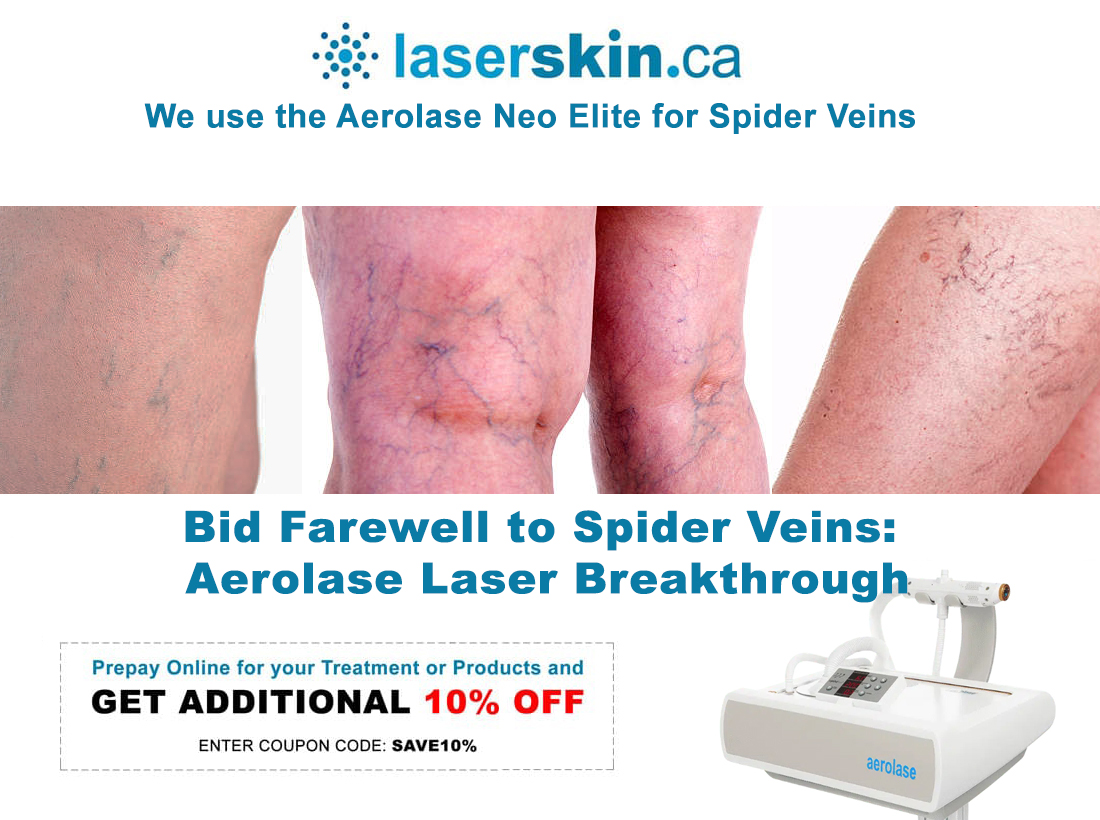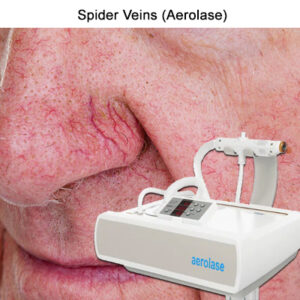
-
Quickview
Spider Veins
$450.00 Select options This product has multiple variants. The options may be chosen on the product page
Bid Farewell to Spider Veins: Aerolase Laser Breakthrough
Aerolase laser treatment presents a promising solution for those troubled by spider veins, addressing a common cosmetic concern that affects many individuals. Spider veins, characterized by their web-like appearance on the skin’s surface, often cause discomfort and self-consciousness. Understanding the nature of these veins and the technology behind Aerolase’s treatment is crucial in evaluating its efficacy and considering it as an option for resolution.
Spider veins, medically termed telangiectasia, are small, dilated blood vessels visible through the skin. Spider veins often manifest on the legs and face, displaying as slender lines in shades of red, blue, or purple, resembling intricate patterns akin to a spider’s web or tree branches. Although usually harmless, they can cause discomfort, such as itching, burning sensations, or aching in the affected area. These veins often arise due to weakened or damaged valves within the veins, allowing blood to pool and enlarge the vessels.
Several factors contribute to the development of spider veins. Genetics plays a significant role, with a family history of the condition increasing one’s likelihood of experiencing it.
Fluctuations in hormones, especially among women during pregnancy or menopause, can also catalyze their emergence. Additionally, prolonged standing or sitting, obesity, and exposure to the sun’s harmful UV rays can exacerbate their formation.
Aerolase laser technology offers a targeted approach to treating spider veins. This cutting-edge treatment employs a specific wavelength of light that targets hemoglobin—the pigment in red blood cells—present in the blood vessels.
The laser’s energy warms and disrupts the walls of the spider veins, leading them to collapse and gradually disappear. Aerolase’s laser treatment stands apart from traditional methods by being non-invasive and causing minimal discomfort.
The advantages of Aerolase laser treatment for spider veins are multifaceted. One significant benefit is its precision targeting the affected veins while leaving the surrounding skin and tissues unharmed. The procedure typically involves minimal discomfort and requires no downtime, allowing individuals to resume their daily activities immediately after treatment. Moreover, Aerolase is effective across various skin types and tones compared to other laser treatments.
Studies have shown promising clinical efficacy and high success rates associated with Aerolase laser treatment for spider veins. Patients often experience a significant reduction in spider veins after several sessions, with visible improvements in the cosmetic appearance and associated discomfort.
Preparing for an Aerolase treatment involves initial consultations with a qualified practitioner. Pre-treatment guidelines may include avoiding medications or supplements that could increase the risk of bruising and discussing any existing medical conditions or allergies.
Patients might sense a mild tingling or warmth as the laser is administered during the procedure, yet the discomfort is generally minimal. Aftercare following Aerolase treatment is relatively straightforward. Post-treatment care instructions typically involve avoiding excessive sun exposure and wearing compression stockings if the practitioner advises. Patients can expect a gradual fading of the treated spider veins over several weeks, with noticeable improvements in the skin’s appearance.
Nevertheless, like all medical procedures, there are potential risks and factors to consider. Although infrequent, potential side effects of Aerolase treatment might involve temporary redness, swelling, or bruising in the treated area. Consulting a qualified practitioner is crucial to assess suitability for the procedure, considering medical history, skin type, and individual expectations.
In conclusion, Aerolase laser treatment represents an effective and minimally invasive solution for addressing spider veins. Understanding its mechanisms, benefits, and considerations allows individuals to make informed decisions about pursuing this innovative approach to improve the appearance and alleviate discomfort associated with spider veins.
Q&A
What are spider veins, and why do they appear?
Spider veins are small, visible blood vessels that often appear on the skin’s surface, resembling spider webs or tree branches. They develop due to various factors, including genetics, hormonal changes, prolonged sitting or standing, obesity, and sun exposure.
How does Aerolase laser treatment work for spider veins?
Aerolase laser treatment uses a specific wavelength of light to target hemoglobin in the blood vessels of spider veins.
This energy raises the temperature and affects the veins, leading them to collapse and eventually fade away from sight.
What are the advantages of Aerolase over traditional methods for spider vein treatment?
Aerolase offers precise targeting of affected veins without harming surrounding skin, minimal discomfort during the procedure, no downtime afterward, and effectiveness across various skin types.
What can one expect during an Aerolase treatment session?
Patients might feel a gentle tingling or warmth during the laser application, yet the discomfort is typically minimal. The procedure is typically brief, allowing patients to resume their daily routines promptly.
The number of Aerolase treatment sessions required for spider vein removal varies based on the severity of the veins and individual responsiveness to the treatment. Optimal results often necessitate multiple sessions spaced several weeks apart.
When assessing the potential side effects associated with Aerolase laser treatment, although infrequent, possible results might encompass temporary redness, swelling, or bruising at the treated site. These effects commonly resolve within a few days to a week.
Who is an ideal candidate for Aerolase treatment?
Ideal candidates for Aerolase treatment are individuals bothered by the appearance or discomfort caused by spider veins, have realistic expectations, and are in good overall health.
What precautions should one take before and after an Aerolase treatment?
Before the procedure, patients may need to avoid certain medications or supplements that could increase the risk of bruising. Afterward, they should follow post-treatment care instructions, including sun protection and, if advised, wearing compression stockings.
Is Aerolase treatment permanent, or do spider veins return?
Aerolase can significantly reduce the appearance of spider veins, but new ones might develop over time. Maintenance sessions may be recommended to address new vein formations or touch up existing treated areas.
How long does it take to see results from Aerolase treatment?
Results vary among individuals, but gradual fading of treated spider veins can be observed over several weeks after the sessions, with noticeable improvements in the skin’s appearance.
Book Your Free Consultation Today Or Call (647) 560-9233
By providing your phone number you agree to receive informational text messages from laserskin.ca. Consent is not a condition of purchase. Message frequency will vary. Msg & data rates may apply. Reply HELP for help or STOP to cancel.

